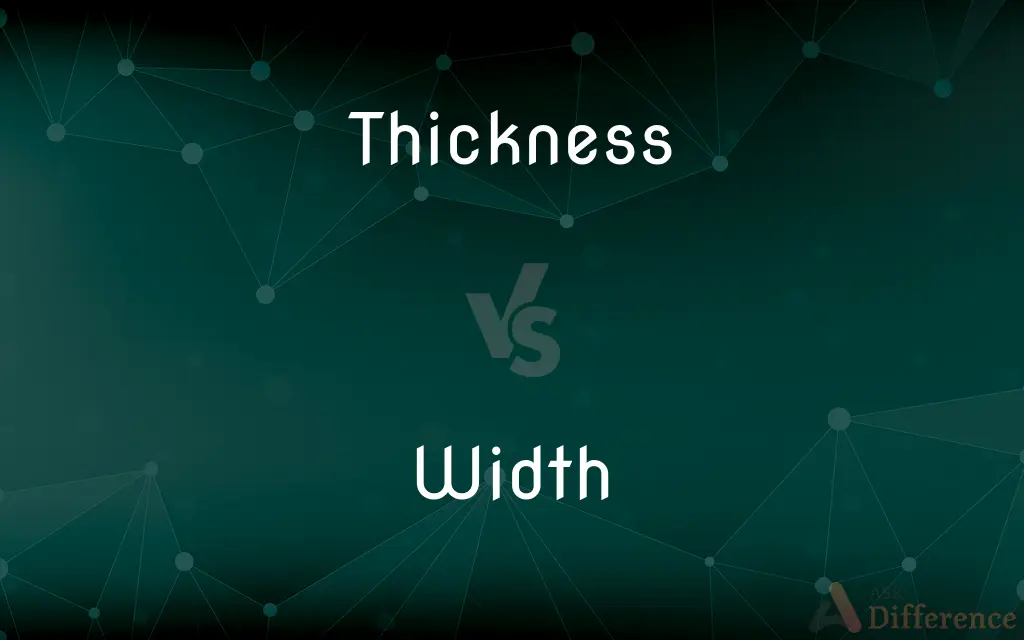Thickness vs. Width — What's the Difference?
Edited by Tayyaba Rehman — By Fiza Rafique — Updated on April 18, 2024
Thickness refers to the measurement of something from one surface to the opposite, typically vertical, while width measures distance from side to side, typically horizontal.

Difference Between Thickness and Width
Table of Contents
ADVERTISEMENT
Key Differences
Thickness refers to the dimension taken through an object from one surface to its opposite, often considered in terms of depth. Width, on the other hand, is the measurement across the narrowest part of an object’s surface, generally perceived as left to right.
Thickness is crucial in contexts where the depth of material plays a functional role, such as insulation where thicker materials can mean better performance. Width is more about spatial dimensions, influencing how objects fit into spaces or align with other objects.
Thickness is often measured in units such as millimeters or inches, using tools like calipers to gauge the depth of objects like sheets, wires, or walls. Width, whereas, might be measured using rulers or tape measures, especially for items like fabric, tables, or rooms.
Thickness can affect the weight and durability of materials. For example, thicker glass can support more weight and withstand greater forces. Width impacts the coverage area and can determine the application of materials like flooring or wrapping paper.
Thickness and width both play critical roles in engineering and construction, but their importance varies by the structural role and material type. Width is often more visually apparent and directly affects how components fit together in assemblies.
ADVERTISEMENT
Comparison Chart
Measurement Axis
Vertical (or through an object)
Horizontal (across the narrowest surface)
Common Units
Millimeters, Inches
Millimeters, Inches, Feet
Tools Used
Calipers, Micrometer
Ruler, Tape measure, Measuring wheel
Associated with
Depth, Durability
Coverage, Fit
Importance
Insulation performance, structural integrity
Space utilization, layout design
Compare with Definitions
Thickness
The extent to which a quantity is dense or concentrated.
The thickness of the crowd at the concert made it hard to move.
Width
The broadness or wideness of an object.
The width of the river changes as it flows into the delta.
Thickness
The dimension from one surface of an object to its opposite surface.
The thickness of the mattress affects its comfort.
Width
A piece measured by its breadth rather than its length.
Cut the timber to a width of two inches.
Thickness
Used to describe the density of solid, liquid, or gaseous substances.
The thickness of the soup was perfect for a hearty meal.
Width
The horizontal extent of a place or a thing.
The width of the bridge supports large vehicles.
Thickness
A measure of how deep or profound something is.
The thickness of the ice on the lake determines if it's safe to skate.
Width
The measurement or extent of something from side to side.
The width of the fabric determines how much is needed for the curtain.
Thickness
In typography, the degree of boldness of a font.
The thickness of the lettering made the text stand out.
Width
In computing, the extent of a data frame or layout across the screen.
The width of the website layout must be responsive.
Thickness
The quality or condition of being thick.
Width
The measurement or extent of something from side to side; the lesser of two or the least of three dimensions of a body
The yard was about seven feet in width
Thickness
The dimension between two surfaces of an object, usually the dimension of smallest measure.
Width
Wide range or extent
The width of experience required for these positions
Thickness
A layer, sheet, stratum, or ply
Each floor is a single thickness of concrete.
Width
The state, quality, or fact of being wide.
Thickness
(uncountable) The property of being thick (in dimension).
Width
Abbr. w The measurement of the extent of something from side to side.
Thickness
A measure of how thick (in dimension) something is.
The thickness of the Earth's crust varies from two to 70 kilometres.
Guitar picks come in different thicknesses.
Width
A piece of material measured along its smaller dimension or its crosswise grain, especially a piece of fabric measured from selvage to selvage.
Thickness
(countable) A layer.
We upholstered the seat with three thicknesses of cloth to make it more comfortable to sit on.
Width
The state of being wide.
Thickness
(uncountable) The quality of being thick (in consistency).
Whip the cream until it reaches a good thickness.
Width
The measurement of the extent of something from side to side.
Thickness
The property of being thick (slow to understand).
Width
A piece of material measured along its smaller dimension, especially fabric.
Thickness
(transitive) To trim (wood) to a consistent thickness using a thickness planer.
Width
(cricket) The horizontal distance between a batsman and the ball as it passes him.
Thickness
The quality or state of being thick (in any of the senses of the adjective).
Width
(sports) The use of all the width of the pitch, from one side to the other.
Manchester United like to play with width.
Thickness
The dimension through an object as opposed to its length or width
Width
The quality of being wide; extent from side to side; breadth; wideness; as, the width of cloth; the width of a door.
Thickness
Used of a line or mark
Width
The extent of something from side to side
Thickness
Resistance to flow
Common Curiosities
In what scenarios is the width of a material critical?
The width is critical in scenarios like manufacturing clothes or furniture, where specific dimensions are necessary for proper fit and function.
Can the thickness of paper influence printing quality?
Yes, the thickness of paper can affect printing quality; thicker paper tends to absorb ink better, reducing bleed-through.
How does the thickness of a material affect its thermal properties?
Thicker materials generally have better insulation properties, retaining more heat or cold.
How do manufacturers determine the necessary thickness of a metal for a specific application?
Manufacturers consider factors like load-bearing capacity, environmental conditions, and cost when determining the necessary thickness.
What role does width play in digital design?
In digital design, width determines how content is displayed across different devices, affecting usability and aesthetics.
Is width considered in the planning of urban spaces?
Yes, width is crucial in urban planning for ensuring adequate space for pedestrian paths, roads, and public transport lanes.
What are some common standards for measuring width in textiles?
Textiles are often measured in widths defined by inches or centimeters, with standard widths for specific types of fabrics.
Does the width of a vehicle affect its road performance?
Yes, the width of a vehicle can impact its stability and maneuverability, with wider vehicles often providing better balance.
How is thickness measured in liquids?
In liquids, "thickness" is often referred to as viscosity and is measured using viscometers.
What tools are commonly used to measure thickness?
Thickness is typically measured with calipers or micrometers.
When is width more important than thickness in construction?
Width is more crucial in construction when determining the space between components, like in framing or laying out rooms.
Why might a narrower width be advantageous in certain products?
A narrower width can be advantageous for products that need to fit into tight spaces or for ease of handling and transport.
How does thickness impact the weight of an object?
Generally, an increase in thickness leads to an increase in weight, as there is more material volume.
What is the difference between the thickness of insulation used in walls versus roofs?
Roof insulation is typically thicker than wall insulation to prevent heat loss, given that heat rises.
What considerations affect the width of pathways in a park?
Considerations include the expected foot traffic, accessibility needs, and the overall design aesthetic of the park.
Share Your Discovery

Previous Comparison
Tragedy vs. Melodrama
Next Comparison
Genius vs. ProdigyAuthor Spotlight
Written by
Fiza RafiqueFiza Rafique is a skilled content writer at AskDifference.com, where she meticulously refines and enhances written pieces. Drawing from her vast editorial expertise, Fiza ensures clarity, accuracy, and precision in every article. Passionate about language, she continually seeks to elevate the quality of content for readers worldwide.
Edited by
Tayyaba RehmanTayyaba Rehman is a distinguished writer, currently serving as a primary contributor to askdifference.com. As a researcher in semantics and etymology, Tayyaba's passion for the complexity of languages and their distinctions has found a perfect home on the platform. Tayyaba delves into the intricacies of language, distinguishing between commonly confused words and phrases, thereby providing clarity for readers worldwide.
















































